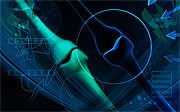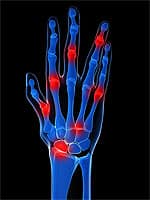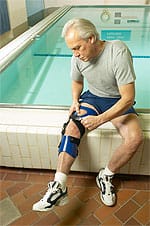Life Extension Magazine®
According to the most recent scientific research, aging individuals afflicted with rheumatoid arthritis are at 60% great-er risk of dying from heart disease than the general population.1 The vascular damage seen in rheumatoid individuals appears to be an accelerated form of atherosclerosis.2 Similar analysis shows that over time, rheumatoid arthritis sufferers also sustain damage to the eyes, lungs, and skin.3-6 The common factor linking rheuma-toid arthritis to these potentially deadly conditions is system-wide, chronic inflammation in the body. The same systemic inflammatory events, especially those involving the potent cytokine known as TNF-alpha, contribute to atherosclerosis even in people who don’t have rheumatoid arthritis7—and that’s why we all need to pay special attention to limiting inflammatory changes throughout our lifetime. Until recently, mainstream medicine’s focus on highly profitable single-target drugs (like Enbrel®) has left the 1.3 million rheumatoid arthritis sufferers in this country with few attractive options. While effective at controlling symptoms, these drugs are expensive and produce potentially life-threatening side effects associated with chronic suppression of immunity, such as serious infections and certain cancers.8-10 Fortunately, a novel set of multi-targeted natural agents has been identified that can disrupt the inflammatory cascade involved in rheumatoid arthritis at many stages. These agents have also been shown to reduce joint pain, stiffness, and deterioration of cartilage. In this article, you will learn about the latest research on curcuminoids and andrographolides—natural compounds shown to specifically target the painful conditions associated with rheumatoid arthritis and the underlying genetic and biochemical factors that cause rheumatoid inflammation. formof curcumin which early evidence shows may be as effective in alleviating the symptoms of rheumatoid arthritis as the non-steroidal anti-inflammatory (NSAID) drug diclofenac! Animal studies already demonstrate that curcumin relieves pain comparably to diclofenac, so this is an exciting and evolving field of research.11
Rheumatoid Arthritis—Inflammation Run AmokWhile its causes are not fully understood, researchers have long known that rheumatoid arthritis (RA) is an autoimmune disorder. An optimally functioning immune system remains on constant alert, patrolling for invading microbes and emerging cancer cells. When launched into action, various immunomodulating agents—including the cell-signaling proteins known as cytokines—provoke an inflammatory response in the body. In healthy individuals, the immune system keeps this inflammatory response under control to prevent injury to the body itself.12 For the unfortunate individuals stricken with rheumatoid arthritis, this balance is disrupted—the body mistakes some of its own tissue as “foreign,” resulting in a chronic inflammatory response. The immune system attacks the delicate synovial membranes that line the joints, producing pain, swelling, bone loss, and overgrowth of the membranes themselves. Eventually joints stiffen, limiting range of motion, accompanied by progressively worsening pain and a severe decline in quality of life.13 RA is one of a growing handful of diseases in which experts have recognized the central role of an inflammatory cytokine called tumor necrosis factor-alpha (TNF-alpha)—the “master regulator” of inflammation in many systems of the body. These conditions—which include psoriasis and inflammatory bowel disease—are collectively known as “TNF Related Chronic Inflammatory Diseases,” or TRECID.14 Mainstream medical research remains largely focused on various drugs that block TNF-alpha as a way to try to stop the damage involved in TRECID diseases.15 Though TNF-blockers like golimumab, infliximab, and adalimumab can be effective, there are some individuals for whom these interventions provide little or no relief.16-18 TNF-blockers can also be extremely expensive, requiring painful periodic injections, with an array of side effects, some of which may paradoxically exacerbate autoimmune disease.18-20 Another main class of pharmaceutical interventions for RA, known as disease-modifying anti-rheumatic drugs (DMARDs), include methotrexate, cyclosporine, and cytoxan.21 These drugs are often less costly, but generally no better in terms of efficacy and side effect profile.22,23 The truth is that tolerable, safe treatment of RA continues to elude pharmaceutical solutions—in large part because they are single-target therapies focused on a limited number (usually just one) of the underlying mechanisms behind RA. The powerful disruption of the immune system by those drugs often produces a comprehensive state of immune deficiency that opens the patient to potentially disastrous infections—the FDA has recently issued “Black Box” warnings for some of the biological agents in this class.10 A novel set of low-cost, natural compounds have emerged that specifically attack the inflammation associated with rheumatoid arthritis at multiple points in the inflammatory process. Together they provide the potential for multi-targeted relief, both “upstream” within the inflammatory cascade—at earlier stages than TNF-blocking drugs—and “downstream,” at later stages than traditional anti-rheumatic drugs (DMARDs). Andrographis: A Multi-Modal Inflammation FighterOver the past 25 years, extracts of the Asian herb Andrographis paniculata have aroused considerable scientific interest owing to their apparent power to favorably modify immune system function.24-26 Its bioactive components, called andrographolides,27 are well absorbed after oral dosing28 and have been extensively tested as anti-inflammatory agents.29
Unlike the single-targeted action of TNF-blockers and anti-rheumatic drugs, andrographolides stimulate beneficial activity at multiple points in the inflammatory process, providing mutually reinforcing effects.29 Andrographolides inhibit activity of the pro-inflammatory compound known as inducible nitric oxide synthase (iNOS). This helps exert a powerful anti-inflammatory effect.30 Readers who are familiar with the vascular benefits of eNOS (endothelial NOS) should note that, unlike eNOS, iNOS is pro-inflammatory and often involved in disease states, where it is desirable to inhibit its actions. Andrographolides suppress production of the pro-inflammatory cytokines TNF-alpha and prostaglandin E2 (PGE-2), preventing their gene expression at multiple levels.31,32 By doing so they downregulate the chemical signaling pathways that cells use to “tell” each other to initiate the inflammatory response that plays a key role in rheumatoid arthritis.33 Scientific analysis has further revealed that andrographolides operate “upstream” within the process of the inflammatory cascade by blocking the effects of the pro-inflammatory transcription factor nuclear factor-kappaB (NF-kB).34 NF-kB is found in almost all human cells. It plays a key role in cellular responses to stress, cytokines, free radicals, oxidized low-density lipoprotein (LDL), and bacterial or viral pathogens. Accordingly, its central role as a first-responder to oxidative damage, infection, and toxin-induced stress links it to inflammation, cancer, and chronic disease.35 NF-kB tightly regulates virtually all factors downstream in the inflammatory cascade, including cytokines known as interleukins, hormones known as prostaglandins, and TNF-alpha. By blocking NF-kB, andrographolides inhibit production of a host of inflammatory mediators in one simple step.36 Just as critically, they permit normal activity of vital immune surveillance cells as they simultaneously suppress over-active inflammatory cells, as demonstrated in animal studies.37 This is a critical feature that distinguishes andrographolides from most anti-rheumatic drugs (DMARDS). While andrographolides suppress inflammatory immune factors,36 DMARDs can suppress immune function in general, resulting in an increased risk of infection.38 Andrographolides also act as powerful antioxidants, limiting the number of free radicals thrown off by inflammatory cells and reducing overall inflammation and pain in animal studies.39-43 Clinical Breakthroughs in Natural Arthritis ReliefIn 2005, a group of researchers led by Dr. Raphael A. Burgos at the Universidad Austral in Valdivia, Chile, began publishing seminal work on the properties of a select formulation of andrographolides in countering the effects of rheumatoid arthritis.
Burgos’s group discovered that the formulation suppressed inflammatory mediators such as interferon-gamma and interleuklin-2 (IL-2), while protecting against cell death induced by corticosteroids.44 They further demonstrated that andrographolides directly prevent NF-kB from binding to DNA in inflammatory cells, thereby preventing it from activating production of dangerous inflammatory mediators.45 In 2009, Burgos’s team was able to demonstrate this andrographolide formulation’s dramatic anti-rheumatic effects for the first time in humans. Just 200 mg daily for 18 weeks resolved RA-related anemia, restoring red blood cell levels to the normal range while lowering the inflammatory marker C-reactive protein (CRP) to normal.46 When rheumatoid arthritis sufferers were given 200 mg of andrographolides or the same dose of a non-steroidal anti-inflammatory drug (NSAID), the patients receiving the andrographolides had a significant drop in RA-specific auto-antibodies (antibodies directed against their own tissue), while the NSAID group saw a rise in some of those levels.47 Relief from joint pain and rigidity was seen in the andrographolide and the NSAID groups. ... Scientific advances in our understanding of curcumin’s molecular action have led to its application in the treatment of rheumatoid arthritis.
After these two preliminary, unpublished studies validated the efficacy of andrographolides, Dr. Burgos’s group subsequently performed a larger study: a prospective, randomized, double blind, placebo-controlled clinical trial. They published the results in late 2009.48 Significant improvements over placebo were found for joint pain and swelling as well as the number and severity of tender, swollen joints. Quality of life scores also improved significantly in the supplemented subjects, and levels of some biochemical markers of immune system activation were decreased in the group who took the active supplement.
| ||||||
Successful RA Intervention with High-Potency CurcuminDerived from the traditional Indian spice turmeric (Curcuma longa), curcumin has been shown to beneficially modulate the underlying mechanisms behind a host of chronic diseases, including cardiovascular disease, cancer, diabetes, Alzheimer’s disease, and osteoporosis, among others.49-61 Scientific advances in our understanding of curcumin’s molecular action have led to its application in the treatment of rheumatoid arthritis as well.54,58,62 andrographolides, curcumin and its main constituents, the curcuminoids, powerfully inhibit NF-kB, downregulating multiple inflammatory pathways. 54,63 Of course, global suppression of immune function is emphatically not desirable since it opens the body up to deadly infections—in fact, that is precisely what makes existing pharmacological therapies potentially dangerous. Curcuminoids, by contrast, can increase normally functioning immune cell numbers in people with recurrent infections,64 and reverses the immune suppression caused by some cancers.65,66 And in animal models of inflammatory arthritis, curcumin can produce a remarkable antigen-specific suppression of inflammation, meaning that only the dangerous inflammatory response is quenched, leaving healthier immune functions unaffected.67
Curcumin suppresses gene expression of matrix metalloproteinases,68 destructive enzymes that dissolve cartilage.69 It also blocks numerous inflammatory signaling molecules that aggravate painful joint inflammation.70,71 Curcumin is a powerful inhibitor of migration inhibitory factor, now thought to play a significant role in many of the symptoms of rheumatoid arthritis.72 Curcumin also blocks the multiple effects of the inflammatory cytokine IL-1beta, which contributes to much of the devastating, painful destruction of joint cartilage symptomatic of rheumatoid arthritis. Lab studies show that curcumin slows the degeneration of cartilage caused by IL-1beta while restoring normal cartilage protein production.73 RA cartilage deterioration is also mediated by an enzyme called collagenase, whose action is also powerfully neutralized by curcumin.74 A newly discovered cytokine called IL-18 may also play a role in rheumatoid arthritis by triggering vascular endothelial growth factor (VEGF), an agent that triggers blood vessel growth (angiogenesis) and thickens joint membranes. Curcumin downregulates IL-18’s stimulatory effect on VEGF, thus reducing angiogenesis and promoting healthy joint membranes.75 In 2006, rheumatologists undertook a study examining curcumin’s efficacy in treating RA.76 They induced rheumatoid-like arthritis in lab rats and then treated them with turmeric extracts rich in curcumin. The scientists reported that the extract “profoundly inhibited joint inflammation and periarticular joint destruction… [and] prevented local activation of NF-kB and the subsequent expression of NF-kB-regulated genes mediating joint inflammation and destruction.” In fact, they conducted other research showing that they could prevent lab-induced rheumatoid arthritis in animals through the use of a special curcumin formulation.77 With respect to its application in humans, the challenge has been that raw curcumin is not well absorbed in the intestinal tract.78 This has proven an obstacle in the scientific application of curcumin for managing the effects of rheumatoid arthritis.68,78 All of that changed in recent years. RA researchers are using an enhanced preparation of curcumin standardized to a 95% concentration of curcuminoids that reincorporate many of the components of raw turmeric root that are normally removed during the extraction process. This enhanced extract was found to be 6 to 7 times more bioavailable than conventional curcumin extracts. Importantly, this enhanced curcumin was absorbed more rapidly and retained longer in the blood, compared with standard curcumin preparations.79,80 In an as-yet-unpublished, randomized, controlled trial, researchers compared this enhanced curcumin preparation to the commonly-used NSAID diclofenac.81 Forty-five subjects with mild to moderate disease activity as rated on a standard score were enrolled and randomly assigned to 3 groups. One group received 500 mg of enhanced curcumin twice daily, another both 500 mg enhanced curcumin and 50 mg diclofenac, and a third group 50 mg diclofenac only, and their conditions were evaluated over the next 8 weeks, including blood testing and disease scoring. The greatest reduction in the disease activity score was attained by the patients treated exclusively with enhanced curcumin. The diclofenac group experienced the least improvement! Similarly, the supplement-only group showed the greatest improvement in the inflammatory blood markers C-reactive protein and antistreptolysin O (ASO).81 SummaryWhile its origin and causes are not fully understood, rheumatoid arthritis involves system-wide, chronic inflammation in the body. Until recently, mainstream medicine’s focus on highly profitable single-target drugs has left the 1.3 million rheumatoid arthritis sufferers in this country with few attractive and affordable options. A novel set of safe, multi-targeted natural agents has been identified that disrupts the inflammatory cascade involved in rheumatoid arthritis at multiple stages. Curcuminoids and andrographolides specifically target the conditions associated with rheumatoid arthritis, including underlying gene transcription factors involved in the body’s inflammatory response. Both compounds provide multi-modal relief from inflammation and other symptoms of rheumatoid arthritis, suppressing inflammatory cytokines throughout the body and reducing joint swelling, pain, and stiffness. Clinical trials suggest they may act as powerful complements or alternatives to some pharmaceutical interventions. If you have any questions on the scientific content of this article, please call a Life Extension® Wellness Specialist at 1-866-864-3027. |
|
| References | |
|
1. Meune C, Touze E, Trinquart L, Allanore Y. Trends in cardiovascular mortality in patients with rheumatoid arthritis over 50 years: a systematic review and meta-analysis of cohort studies. Rheumatology (Oxford). 2009 Oct;48(10):1309-13. 2. Tanasescu C, Jurcut C, Jurcut R, Ginghina C. Vascular disease in rheumatoid arthritis: from subclinical lesions to cardiovascular risk. Eur J Intern Med. 2009 Jul;20(4):348-54. 3. Wolfe F, Michaud K. Prevalence, risk, and risk factors for oral and ocular dryness with particular emphasis on rheumatoid arthritis. J Rheumatol. 2008 Jun;35(6):1023-30. 4. Bettero RG, Cebrian RF, Skare TL. Prevalence of ocular manifestation in 198 patients with rheumatoid arthritis: a retrospective study. Arq Bras Oftalmol. 2008May-Jun;71(3):365-9. 5. Shaw C, Banik S, Islam MN, Biswas MC, Biswas G, Biswas S. Rheumatoid arthritis and ocular involvement. J Indian Med Assoc. 2003 Sep;101(9):537-8. 6. Available at: http://emedicine.medscape.com/article/331715-overview. Accessed December 16, 2009. 7. Branen L, Hovgaard L, Nitulescu M, Bengtsson E, Nilsson J, Jovinge S. Inhibition of tumor necrosis factor-alpha reduces atherosclerosis in apolipoprotein E knockout mice. Arterioscler Thromb Vasc Biol. 2004 Nov;24(11):2137-42. 8. Carli P, Landais C, Aletti M, Cournac JM, Poisnel E, Paris JF. Current treatment of rheumatoid arthritis. Rev Med Interne. 2009 Dec;30(12):1067-79. 9. Pugner KM, Scott DI, Holmes JW, Hieke K. The costs of rheumatoid arthritis: an international long-term view. Semin Arthritis Rheum. 2000 Apr;29(5):305-20. 10. Barclay L. Black box warning issued for etanercept regarding infections. Medscape Medical News. 2008. 11. Mittal N, Joshi R, Hota D, Chakrabarti A. Evaluation of antihyperalgesic effect of curcumin on formalin-induced orofacial pain in rat. Phytother Res. 2009 Apr;23(4):507-12. 12. Oke SL, Tracey KJ. The inflammatory reflex and the role of complementary and alternative medical therapies. Ann N Y Acad Sci. 2009 Aug;1172:172-80. 13. Kalyoncu U, Dougados M, Daures JP, Gossec L. Reporting of patient-reported outcomes in recent trials in rheumatoid arthritis: a systematic literature review. Ann Rheum Dis. 2009 Feb;68(2):183-90. 14. Muller-Ladner U, Alten R, Heiligenhaus A, et al. “TRECID”, TNFalpha related chronic inflammatory diseases—a new multiple diseases bridging concept. Dtsch Med Wochenschr. 2009 Oct;134(42):2132-6. 15. Wiedmann MW, Mossner J, Baerwald C, Pierer M. TNF alpha inhibition as treatment modality for certain rheumatologic and gastrointestinal diseases. Endocr Metab Immune Disord Drug Targets. 2009 Sep;9(3):295-314. 16. Scrivo R, Conti F, Spinelli FR, et al. Switching between TNFalpha antagonists in rheumatoid arthritis: personal experience and review of the literature. Reumatismo. Apr- 2009 Jun;61(2):107-17. 17. Saito K, Tanaka Y. New biologic and non biologic disease modifying anti-rheumatic drugs for rheumatoid arthritis. Nihon Rinsho Meneki Gakkai Kaishi. 2009 Jun;32(3):149-59. 18. Gibbons LJ, Hyrich KL. Biologic therapy for rheumatoid arthritis: clinical efficacy and predictors of response. BioDrugs. 2009;23(2):111-24. 19. Diaz-Jouanen E, Abud-Mendoza C, Garza-Elizondo MA, et al. Guidelines in RA treatment: concepts on safety and recommendations using anti-TNF-alpha inhibitors. Grupo de Estudio de Nuevas Terapias de Enfermedades reumaticas (GENTE). Rev Invest Clin. 2009 May-Jun; 61(3):252-66. 20. Caramaschi P, Bambara LM, Pieropan S, Tinazzi I, Volpe A, Biasi D. Anti-TNFalpha blockers, autoantibodies and autoimmune diseases. Joint Bone Spine. 2009 Jul;76(4):333-42. 21. Available at: http://www.webmd.com/rheumatoid-arthritis/modifying-medications. Accessed December 16, 2009. 22. Finckh A, Bansback N, Marra CA, et al. Treatment of very early rheumatoid arthritis with symptomatic therapy, disease-modifying antirheumatic drugs, or biologic agents: a cost-effectiveness analysis. Ann Intern Med. 2009 Nov 3;151(9):612-21. 23. Doan QV, Chiou CF, Dubois RW. Review of eight pharmacoeconomic studies of the value of biologic DMARDs (adalimumab, etanercept, and infliximab) in the management of rheumatoid arthritis. J Manag Care Pharm. 2006 Sep;12(7):555-69. 24. Ji L, Liu T, Liu J, Chen Y, Wang Z. Andrographolide inhibits human hepatoma-derived Hep3B cell growth through the activation of c-Jun N-terminal kinase. Planta Med. 2007 Oct;73(13):1397-401. 25. Lin FL, Wu SJ, Lee SC, Ng LT. Antioxidant, antioedema and analgesic activities of Andrographis paniculata extracts and their active constituent andrographolide. Phytother Res. 2009 Jul;23(7):958-64. 26. Deng WL. Pharmacological studies on thirteen kinds of injections from Andrographis paniculata. I. Antipyretic, anti-inflammatory effects and toxicity. Zhong Yao Tong Bao. 1985 Jul;10(7):38-42. 27. Xu T, Pan J, Zhao L. Simultaneous determination of four andrographolides in Andrographis paniculata Nees by silver ion reversed-phase high-performance liquid chromatography. J Chromatogr Sci. 2008 Sep;46(8):747-50. 28. Akowuah GA, Zhari I, Mariam A, Yam MF. Absorption of andrographolides from Andrographis paniculata and its effect on CCl(4)-induced oxidative stress in rats. Food Chem Toxicol. 2009 Sep;47(9):2321-6. 29. Abu-Ghefreh AA, Canatan H, Ezeamuzie CI. In vitro and in vivo anti-inflammatory effects of andrographolide. Int Immunopharmacol. 2009 Mar;9(3):313-8. 30. Chiou WF, Chen CF, Lin JJ. Mechanisms of suppression of inducible nitric oxide synthase (iNOS) expression in RAW 264.7 cells by andrographolide. Br J Pharmacol. 2000 Apr;129(8):1553-60. 31. Liu J, Wang ZT, Ji LL. In vivo and in vitro anti-inflammatory activities of neoandrographolide. Am J Chin Med. 2007;35(2):317-28. 32. Liu J, Wang ZT, Ji LL, Ge BX. Inhibitory effects of neoandrographolide on nitric oxide and prostaglandin E2 production in LPS-stimulated murine macrophage. Mol Cell Biochem. 2007 Apr;298(1-2):49-57. 33. Liu J, Wang ZT, Ge BX. Andrograpanin, isolated from Andrographis paniculata, exhibits anti-inflammatory property in lipopolysaccharide-induced macrophage cells through down-regulating the p38 MAPKs signaling pathways. Int Immunopharmacol. 2008 Jul;8(7):951-8. 34. Bao Z, Guan S, Cheng C, et al. A novel antiinflammatory role for andrographolide in asthma via inhibition of the nuclear factor-kappaB pathway. Am J Respir Crit Care Med. 2009 Apr 15;179(8):657-65. 35. Ahn KS, Aggarwal BB. Transcription Factor NF-{kappa}B: A sensor for smoke and stress signals. Ann N Y Acad Sci. 2005 Nov;1056:218-33. 36. Chao WW, Kuo YH, Hsieh SL, Lin BF. Inhibitory effects of ethyl acetate extract of Andrographis paniculata on NF-{kappa}B trans-activation activity and LPS-induced acute inflammation in mice. Evid Based Complement Alternat Med. 2009 Sep 10. 37. Naik SR, Hule A. Evaluation of immunomodulatory activity of an extract of andrographolides from Andographis paniculata. Planta Med. 2009 Jun;75(8):785-91. 38. Manganelli P, Troise Rioda W. Weekly low-dose methotrexate in rheumatoid arthritis. Review of the literature. Minerva Med. 1993 Oct;84(10):541-52. 39. Shen YC, Chen CF, Chiou WF. Suppression of rat neutrophil reactive oxygen species production and adhesion by the diterpenoid lactone andrographolide. Planta Med. 2000 May;66(4):314-7. 40. Shen YC, Chen CF, Chiou WF. Andrographolide prevents oxygen radical production by human neutrophils: possible mechanism(s) involved in its anti-inflammatory effect. Br J Pharmacol. 2002 Jan;135(2):399-406. 41. Sheeja K, Shihab PK, Kuttan G. Antioxidant and anti-inflammatory activities of the plant Andrographis paniculata Nees. Immunopharmacol Immunotoxicol. 2006;28(1):129-40. 42. Suebsasana S, Pongnaratorn P, Sattayasai J, Arkaravichien T, Tiamkao S, Aromdee C. Analgesic, antipyretic, anti-inflammatory and toxic effects of andrographolide derivatives in experimental animals. Arch Pharm Res. 2009 Sep;32(9):1191-200. 43. Sulaiman MR, Zakaria ZA, Abdul Rahman A, et al. Antinociceptive and antiedematogenic activities of andrographolide iIsolated from andrographis paniculata in animal models. Biol Res Nurs. 2009 Aug 18. 44. Burgos RA, Seguel K, Perez M, et al. Andrographolide inhibits IFN-gamma and IL-2 cytokine production and protects against cell apoptosis. Planta Med. 2005 May;71(5):429-34. 45. Hidalgo MA, Romero A, Figueroa J, et al. Andrographolide interferes with binding of nuclear factor-kappaB to DNA in HL-60-derived neutrophilic cells. Br J Pharmacol. 2005 Mar;144(5):680-6. 46. Rheumatoid arthritis human clinical trial I. Paractin Research Summary. Bradenton, FL: HP Ingredients; 2009. Data on file. 47. Paractin double-blind, placebo controlled, rheumatoid arthritis research. Paractin Research Summary. Bradenton, FL: HP Ingredients; 2009. Data on file. 48. Burgos RA, Hancke JL, Bertoglio JC, et al. Efficacy of an Andrographis paniculata composition for the relief of rheumatoid arthritis symptoms: a prospective randomized placebo-controlled trial. Clin Rheumatol. 2009 Aug;28(8):931-46. 49. Aggarwal BB, Sundaram C, Malani N, Ichikawa H. Curcumin: the Indian solid gold. Adv Exp Med Biol. 2007;59:51-75. 50. Araujo CC, Leon LL. Biological activities of Curcuma longa L. Mem Inst Oswaldo Cruz. 2001 Jul;96(5):723-8. 51. No authors. Curcuma longa (turmeric). Monograph. Altern Med Rev. 2001 Sep;6 Suppl S62-6. 52. Limtrakul P. Curcumin as chemosensitizer. Adv Exp Med Biol. 2007;595:269-300. 53. Lin JK. Molecular targets of curcumin. Adv Exp Med Biol. 2007;595:227-43. 54. Shishodia S, Singh T, Chaturvedi MM. Modulation of transcription factors by curcumin. Adv Exp Med Biol. 2007;595:127-48. 55. Bright JJ. Curcumin and autoimmune disease. Adv Exp Med Biol. 2007;595:425-51. 56. Miriyala S, Panchatcharam M, Rengarajulu P. Cardioprotective effects of curcumin. Adv Exp Med Biol. 2007;595:359-77. 57. Thangapazham RL, Sharma A, Maheshwari RK. Beneficial role of curcumin in skin diseases. Adv Exp Med Biol. 2007;595:343-57. 58. Shishodia S, Sethi G, Aggarwal BB. Curcumin: getting back to the roots. Ann NY Acad Sci. 2005 Nov;1056:206-17. 59. Menon VP, Sudheer AR. Antioxidant and anti-inflammatory properties of curcumin. Adv Exp Med Biol. 2007;595:105-25. 60. Jagetia GC, Aggarwal BB. “Spicing up” of the immune system by curcumin. J Clin Immunol. 2007 Jan;27(1):19-35. 61. Maheshwari RK, Singh AK, Gaddipati J, Srimal RC. Multiple biological activities of curcumin: a short review. Life Sci. 2006 Mar 27;78(18):2081-7. 62. Deodhar SD, Sethi R, Srimal RC. Preliminary study on antirheumatic activity of curcumin (diferuloyl methane). Indian J Med Res. 1980 Apr;71:632-4. 63. Jurenka JS. Anti-inflammatory properties of curcumin, a major constituent of Curcuma longa: a review of preclinical and clinical research. Altern Med Rev. 2009 Jun;14(2):141-53. 64. Zuccotti GV, Trabattoni D, Morelli M, Borgonovo S, Schneider L, Clerici M. Immune modulation by lactoferrin and curcumin in children with recurrent respiratory infections. J Biol Regul Homeost Agents. 2009 Apr-Jun;23(2):119-23. 65. Zhang HG, Kim H, Liu C, et al. Curcumin reverses breast tumor exosomes mediated immune suppression of NK cell tumor cytotoxicity. Biochim Biophys Acta. 2007 Jul;1773(7):1116-23. 66. Pal S, Bhattacharyya S, Choudhuri T, Datta GK, Das T, Sa G. Amelioration of immune cell number depletion and potentiation of depressed detoxification system of tumor-bearing mice by curcumin. Cancer Detect Prev. 2005;29(5):470-8. 67. Capini C, Jaturanpinyo M, Chang HI, et al. Antigen-specific suppression of inflammatory arthritis using liposomes. J Immunol. 2009 Mar 15;182(6):3556-65. 68. Henrotin Y, Clutterbuck AL, Allaway D, et al. Biological actions of curcumin on articular chondrocytes. Osteoarthritis Cartilage. 2009 Oct 8. 69. Onodera S, Kaneda K, Mizue Y, Koyama Y, Fujinaga M, Nishihira J. Macrophage migration inhibitory factor up-regulates expression of matrix metalloproteinases in synovial fibroblasts of rheumatoid arthritis. J Biol Chem. 2000 Jan 7;275(1):444-50. 70. Li WQ, Dehnade F, Zafarullah M. Oncostatin M-induced matrix metalloproteinase and tissue inhibitor of metalloproteinase-3 genes expression in chondrocytes requires Janus kinase/STAT signaling pathway. J Immunol. 2001 Mar 1;166(5):3491-8. 71. Kawasaki H, Komai K, Nakamura M, et al. Human wee1 kinase is directly transactivated by and increased in association with c-Fos/AP-1: rheumatoid synovial cells overexpressing these genes go into aberrant mitosis. Oncogene. 2003 Oct 9;22(44):6839-44. 72. Molnar V, Garai J. Plant-derived anti-inflammatory compounds affect MIF tautomerase activity. Int Immunopharmacol. 2005 May;5(5):849-56. 73. Shakibaei M, Schulze-Tanzil G, John T, Mobasheri A. Curcumin protects human chondrocytes from IL-l1beta-induced inhibition of collagen type II and beta1-integrin expression and activation of caspase-3: an immunomorphological study. Ann Anat. 2005 Nov;187(5-6):487-97. 74. Jackson JK, Higo T, Hunter WL, Burt HM. The antioxidants curcumin and quercetin inhibit inflammatory processes associated with arthritis. Inflamm Res. 2006 Apr;55(4):168-75. 75. Cho ML, Jung YO, Moon YM, et al. Interleukin-18 induces the production of vascular endothelial growth factor (VEGF) in rheumatoid arthritis synovial fibroblasts via AP-1-dependent pathways. Immunol Lett. 2006 Mar 15;103(2):159-66. 76. Funk JL, Frye JB, Oyarzo JN, et al. Efficacy and mechanism of action of turmeric supplements in the treatment of experimental arthritis. Arthritis Rheum. 2006 Nov;54(11):3452-64. 77. Funk JL, Oyarzo JN, Frye JB, et al. Turmeric extracts containing curcuminoids prevent experimental rheumatoid arthritis. J Nat Prod. 2006 Mar;69(3):351-5. 78. Bisht S, Maitra A. Systemic delivery of curcumin: 21st century solutions for an ancient conundrum. Curr Drug Discov Technol. 2009 Sep;6(3):192-9. 79. Antony B, Merina B, Iyer S, Judy N, Lennertz K, Joyal S. A pilot cross-over study to evaluate human oral bioavailability of BCM-95® CG (Biocurcumax™), a novel bioenhanced preparation of curcumin. Indian J Pharm Sci. 2008 Jul-Aug; 70(4):445-50. 80. Benny M, Antony B. Bioavailability of Biocurcumax (BCM-095™). Spice India. 2006 Sept 9;19(9):11-5. 81. Chandran B, Chakkiath VK, Thomas SPO. A Multicentre, Randomized, Controlled Human Clinical Study to Assess the Efficacy and Safety of Biocurcumax TM (BCM-95) Compared to Diclofenac sodium in the Management of Active Rheumatoid Arthritis. Kerala, India: Arjuna Natural Extracts Limited; 2009. |





